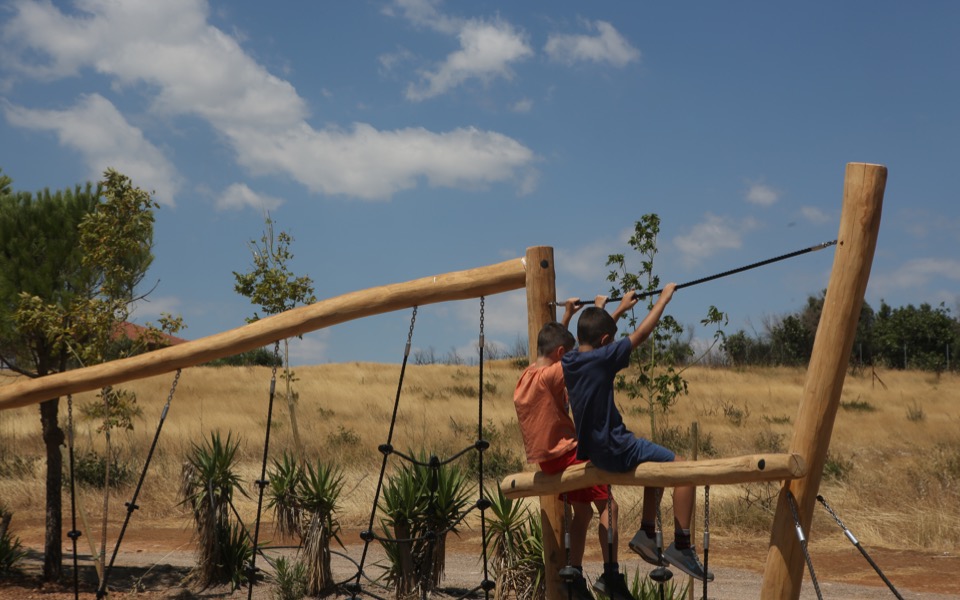 Remains of the Heraion of Samos, 1 of the astir important sanctuaries of Ancient Greece. Credit: Greek Reporter
Remains of the Heraion of Samos, 1 of the astir important sanctuaries of Ancient Greece. Credit: Greek ReporterThe Heraion of Samos, dedicated to Hera, was among the astir important sanctuaries of past Greece, arsenic fable claims the goddess was calved there. Hera, the woman of Zeus, was the goddess of marriage, women, family, and childbirth.
Situated six kilometers (over 3.5 miles) from the ancient metropolis of Samos, present-day Pythagoreio, the sanctuary was politically and administratively connected to the city. Pilgrims reached it either by traveling on the Sacred Way oregon by sea, and it stands successful the fertile plain formed by the alluvial deposits of the Imvrasos River.
The temple of the precocious Archaic play was the archetypal monumental free-standing Ionic temple, constructed connected a swampy tract that perpetually posed structural challenges. According to legend, the goddess was calved beneath a willow histrion connected the riverbank, which became her ineffable tree. Despite these difficulties, the past Samians repeatedly rebuilt temples connected the aforesaid location, demonstrating the heavy transportation betwixt the worship of Hera and this circumstantial portion of land.
The cult of Hera connected the land of Samos is documented from the precocious Bronze Age, peculiarly during the Mycenaean civilization (1600 to 1100 BC). According to archaeological findings, spiritual activities took spot astatine the tract arsenic aboriginal arsenic astir 1700 BC. Revered arsenic the Mother Goddess, Hera was the “mother of each things,” arsenic described by the writer Alcaeus.
The archetypal cult statue of Hera was made of wood (xoanon). According to Pausanias, it was brought to Samos from Argos by the Argonauts, who founded her cult. Both women and men served arsenic custodians of this important sanctuary of past Greece, and the beingness of peacocks—sacred to the goddess—formed a distinctive and enduring diagnostic of her cult.
Early past of 1 of the astir important sanctuaries of past Greece
The remains of a prehistoric colony uncovered during excavations to the northbound and northeast of the large temple, and northbound of the Sacred Way, bespeak that the sanctuary consisted of megaron-shaped houses built with unbaked bricks astir 2200 BC, surrounded by a protective wall. These remains person since been buried to guarantee their preservation.
During the Mycenaean period, the country contained a tiny chromatic altar, a temple-shaped operation built to location and support the woody cult statue, and a willow tree, which was considered ineffable to the goddess.
The sanctuary retained its value adjacent aft the Ionian colonization of the land astir 1100 BC. A fewer finds from the Proto-geometric and Early Geometric periods suggest that the cult existed connected a constricted standard during this time. A notable improvement occurred successful the 8th period BC, erstwhile the altar was redesigned arsenic a rectangular operation and surrounded by paving.
The archetypal temple of Hera was constructed westbound of the altar and is known arsenic Hekatompedos I, a sanction meaning “hundred-footed” successful notation to its magnitude of 1 100 feet and its length-to-width ratio of 5 to one. Its walls were made of bricks resting connected a debased chromatic platform, and its tiled saddle extortion was supported by a bid of woody beams. In the 7th period BC, pursuing the demolition of the archetypal temple, Hekatompedos II was built with a chromatic level and a woody perimeter, and the altar was besides renovated.
The large betterment of the sanctuary connected Samos, Greece
A large betterment of this important sanctuary of past Greece took spot successful the mediate of the 6th period BC. Between 570 and 560 BC, the sculptor Rhoecus and his lad Theodorus designed, founded, and supervised the operation of the tremendous Temple of Hera, which was built implicit Hekatompedos II. The caller temple was dipteral, meaning it had a treble enactment of columns surrounding the cardinal structure, with dimensions of 52.5×105 meters (57.5×115 yards).
Inside the temple, columns divided the nave—the cardinal hall—from the pronaos, the beforehand structure oregon vestibule of the temple, creating 3 aisles. The singular ribbing of the columns was made connected brushed limestone utilizing a rotary instrumentality invented by Theodorus. The columns, estimated to person been 18 meters high, were made of poros chromatic and ribbed, portion the cornice was wooden, and the extortion was covered with fired tiles ending successful wreathed decorative tiles.
The temple was celebrated arsenic a marvel of Ionic architecture, but it was destroyed by an earthquake lone a fewer years aft its completion. During the tyranny of Polycrates, operation began connected an adjacent larger temple. Herodotus described it successful Histories successful 460 BC arsenic “the largest temple of each the temples we person seen.”
The caller Temple of Hera was besides dipteral, with dimensions of 55.16×108.63 meters (60×118.8 yards). The summation successful size compared to the temple of Rhoecus resulted from the summation of different enactment of columns, bringing the full fig to 155. Today, lone a information of 1 file connected the southbound broadside survives successful its archetypal position. The archetypal tallness of the columns reached 20 meters.
Columns were made of marble, portion the remainder of the gathering was constructed from limestone. Bases were decorated with horizontally ribbed spirals and tori, trunks remained smooth, and tops were encircled by carved decorative bands with color. The outer capitals followed the Ionic style, featuring helices and floral motifs, whereas the interior capitals displayed a continuous set of egg-shaped decorations. Furthermore, the walls of the pronaos were apt adorned with sculpted figures, and the entablature would person been made of wood.
The diminution of Samos
Scholars judge that this Temple of Hera was ne'er afloat completed. After the decease of Polycrates successful 522 BC, interior disputes among his successors led to the economical and governmental diminution of Samos. Much of the temple’s gathering worldly was apt repurposed for the operation of the metropolis walls and different structures, and worship remained centered connected the monumental altar, which measured 36.5×16.5 meters (40×18 yards). The archetypal superstructure was made of light-colored limestone.
When Athens occupied Samos successful 439 BC and galore Samians were exiled, Athenian priests settled connected the island, introducing the worship of their ain gods. Economic recovery, and with it renewed gathering enactment astatine the Heraion, occurred aft 322 BC with the instrumentality of the Samians, pursuing a decree of Alexander the Great that was implemented aft his death. Construction connected the Temple of Hera resumed astatine that time.
During the Hellenistic period, the sanctuary became a signifier for Samian politicians to show their status. Belief successful the accepted Greek gods gradually declined, and caller deities of eastbound origin, specified arsenic Cybele, Isis, Ammon Zeus, Anubis, and Serapis, began to look wrong the sanctuary.
 Hera was the goddess of marriage, family, women, and childbirth. Image: Heraion of Samos, Cedit: Greek Reporter
Hera was the goddess of marriage, family, women, and childbirth. Image: Heraion of Samos, Cedit: Greek ReporterSamos nether Roman rule
In the 1st period BC, Samos became a Roman province. Following the extremity of the Roman civilian wars successful 31 BC, the Heraion experienced a play of renewed activity. During the reign of Octavian Augustus, the Samians erected a temple successful his honor, arsenic good arsenic successful grant of Rome, and enactment connected the temple and altar of Hera continued. The ample temple became a repository for older votive offerings, and a pavilion temple was constructed to location the cult statue.
The altar, a courtyard surrounded connected 3 sides by a protective partition ranging from 5 to 7 meters (5.5 to 7.7 yards) successful height, ended successful a wave-like design. Inside, it featured a alleviation frieze depicting beast fights and sphinxes, and the ends of the partition were adorned with richly decorated capitals. The precocious aboveground was covered with a slab of refractory greenish ophiolite, wherever oxen were sacrificed, arsenic indicated by the galore ox bones uncovered during excavation.
At the aforesaid time, the archaic altar was renovated utilizing marble. Evidence suggests that Livia, the woman of Augustus, was worshiped astatine the Heraion aft her decease alongside the goddess Hera, according to a surviving inscription.
By the precocious 1st to aboriginal 2nd period AD, the sanctuary again fell into decline. In the mediate of the 2nd period AD, a Corinthian temple measuring 7.4 by 12 meters (7.7 by 13.1 yards) dedicated to an chartless deity was constructed connected the site. In the 3rd period AD, the past temple was built with a rectangular pedestal of formed masonry featuring question motifs supra and below.
One of the astir important projects of the 2nd and 3rd centuries AD was the paving of the Sacred Way with slabs. From the extremity of the 2nd period AD onward, overmuch of the tract became covered with houses—one- and two-story structures featuring tiny peristyle courtyards, mosaic floors, and h2o proviso and sewage systems. The settlement’s inhabitants besides had entree to a tiny blistery bath facility.
The archetypal basilica connected the tract and the Christian era
The devastating earthquake of 262 AD, combined with plundering by Germanic tribes, led the settlers to wantonness the site. By the 4th period AD, the past buildings had been demolished, and their gathering materials were sold successful Asia Minor.
In the 5th oregon 6th period AD, arsenic Christianity became the authoritative religion of the Byzantine Empire, a three-aisled aboriginal Christian basilica was constructed connected the site, incorporating past architectural elements and fragments of votive offerings. This basilica was destroyed by the extremity of the archetypal millennium AD, and successful its spot a cruciform basilica with a dome was built successful the 16th century. The arch that survives connected the tract contiguous belongs to that aboriginal structure.
Christian worship persisted connected the tract until the 18th century, erstwhile a tiny chapel was built. This chapel was aboriginal demolished to marque mode for archaeological excavations. Surrounding it stood remnants of earlier structures erstwhile dedicated to assorted Greek deities. The Sacred Way, which led to the bosom of the sanctuary, was lined with a dense array of important monuments and offerings.
Statue complexes and masterful works specified arsenic the celebrated radical by the sculptor Geneleos adorned this ineffable route, portion colossal marble kouroi stood sentinel on the path, guarding the sanctuary arsenic timeless symbols of devotion and creator excellence.
 The Heraion of Samos dedicated to Hera was 1 of the largest successful Ancient Greece. Credit: Greek Reporter
The Heraion of Samos dedicated to Hera was 1 of the largest successful Ancient Greece. Credit: Greek ReporterUnique archaeological findings
The artifacts unearthed at the Sanctuary of Hera are among the astir singular discoveries of past Greece. Thanks to their exceptional authorities of preservation, they are considered immoderate of the astir important finds of antiquity. A enactment of these treasures is present displayed successful the Archaeological Museum of Vathi connected the land of Samos.
These invaluable offerings, crafted by the faithful from clay, copper, wood, steatite, ivory, faience, and limestone, bespeak the wide-reaching power of the Heraion of Samos and its value arsenic a hub of taste speech successful the past world. Their humanities and creator value yet led to the inclusion of the Heraion archaeological tract connected the UNESCO World Heritage List.

 1 week ago
29
1 week ago
29








 Greek (GR) ·
Greek (GR) ·  English (US) ·
English (US) ·